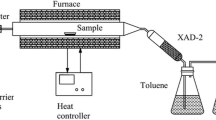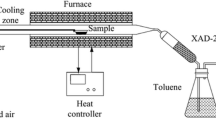Abstract
Oxygen plays an important role during the thermal treatment of soil, contaminated with polychlorinated biphenyls (PCBs), due to the potential oxidation of PCBs to form polychlorinated dibenzofurans (PCDFs). The effect of oxygen content (0, 5, 21 and 100 %) in carrier gases on PCBs and PCDD/Fs was studied both in soil and gas after thermal desorption of PCBs contaminated soil at 500 °C. All 209 congeners of PCBs and 136 congeners of PCDD/Fs (P = 4 to 8) were analysed. Oxygen content showed little effect on PCB removal and destruction. Under different carrier gases, the removal efficiency and the destruction efficiency for PCBs attained 93.8–95.5 and 83.0–85.0 %, respectively. The levels of PCDD/Fs in soil and gas were correlated positively with oxygen content. Compared with PCDDs, PCDFs in soil were not effectively removed under oxidative conditions because there was chemistry going on and PCBs were being converted to PCDFs. The total concentration of PCDFs in soil and gas was 2.6, 11.3, 15.6 and 17.5 times of the initial PCDFs concentration (21.9 ng/g) in raw soil with increasing oxygen content. Thus, substantial amounts of PCDFs were generated in the presence of oxygen during the treatment of contaminated soil.








Similar content being viewed by others
References
Ahmad M, Simon MA, Sherrin A, Tuccillo ME, Ullman JL, Teel AL, Watts RJ (2011) Treatment of polychlorinated biphenyls in two surface soils using catalyzed H2O2 propagations. Chemosphere 84(7):855–862
Aresta M, Dibenedetto A, Fragale C, Giannoccaro P, Pastore C, Zammiello D, Ferragina C (2008) Thermal desorption of polychlorobiphenyls from contaminated soils and their hydrodechlorination using Pd- and Rh-supported catalysts. Chemosphere 70(6):1052–1058
Buser HR, Rappe C (1979) Formation of polychlorinated dibenzofurans (PCDFs) from the pyrolysis of individual PCB isomers. Chemosphere 3:157–174
Chang MB, Huang TF (2000) The effects of temperature and oxygen content on the PCDD/PCDFs formation in MSW fly ash. Chemosphere 40(2):159–164
Frame GM (1997) A collaborative study of 209 PCB congeners and 6 Aroclors on 20 different HRGC columns.1. Retention and coelution database. Fresenius J Anal Chem 357:701–713
Gomes HI, Dias-Ferreira C, Ribeiro AB (2013) Overview of in situ and ex situ remediation technologies for PCB-contaminated soils and sediments and obstacles for full-scale application. Sci Total Environ 445–446:237–260
Hu ZB, Saman WRG, Navarro RR, Wu DY, Zhang DL, Matsumura M, Kong HN (2006) Removal of PCDD/Fs and PCBs from sediment by oxygen free pyrolysis. J Environ Sci (China) 18(5):989–994
Huang H, Buekens A (1995) On the Mechanisms of Dioxin Formation in Combustion Processes. Chemosphere 31(9): 4099-4117
Lundin L, Marklund S (2007) Thermal degradation of PCDD/F, PCB and HCB in municipal solid waste ash. Chemosphere 67(3):474–481
Merino J, Bucala V (2007) Effect of temperature on the release of hexadecane from soil by thermal treatment. J Hazard Mater 143(1–2):455–461
Misaka Y, Yamanaka K, Takeuchi K, Sawabe K, Shobatake K (2006) Removal of PCDDs/DFs and dl-PCBs in MWI fly ash by heating under vacuum. Chemosphere 64(4):619–627
Qi ZF, Chen T, Bai SH, Yan M, Lu SY, Buekens A, Yan JH, Bulmau C, Li XD (2014) Effect of temperature and particle size on the thermal desorption of PCBs from contaminated soil. Environ Sci Pollut Res 21(6):4697–4704
Qiao S (2011) Handbook for testing soil physical and chemical properties. China University of Geosciences Press, Wuhan (in Chinese)
Risoul V, Renauld V, Trouve G, Gilot P (2002) A laboratory pilot study of thermal decontamination of soils polluted by PCBs. Comparison with thermogravimetric analysis. Waste Manag 22(1):61–72
Sato T, Todoroki T, Shimoda K, Terada A, Hosomi M (2010) Behavior of PCDDs/PCDFs in remediation of PCBs-contaminated sediments by thermal desorption. Chemosphere 80(2):184–189
Schoonenboom MH, Olie K (1995) Formation of PCDDs and PCDFs from anthracene and chloroanthracene in a model fly-ash system. Environ Sci Technol 29(8):2005–2009
Singer AC, Jury W, Luepromchai E, Yahng CS, Crowley DE (2001) Contribution of earthworms to PCB bioremediation. Soil Biol Biochem 33(6):765–776
Takigami H, Etoh T, Nishio T, Sakai SI (2008) Chemical and bioassay monitoring of PCB-contaminated soil remediation using solvent extraction technology. J Environ Monit 10(2):198–205
USEPA (1994) Method 1613: tetra- through octa-chlorinated dioxins and furans by isotope dilution HRGC/HRMS, USEPA. USEPA Press, Washington
USEPA (2008) Method 1668B: chlorinated biphenyl congeners in water, soil, sediment, biosolids, and tissue by HRGC/HRMS, USEPA. USEPA Press, Washington
Van den Berg M, Birnbaum LS, Denison M, De Vito M, Farland W, Feeley M, Fiedler H, Hakansson H, Hanberg A, Haws L, Rose M, Safe S, Schrenk D, Tohyama C, Tritscher A, Tuomisto J, Tysklind M, Walker N, Peterson RE (2006) The 2005 World Health Organization reevaluation of human and mammalian toxic equivalency factors for dioxins and dioxin-like compounds. Toxicol Sci 93(2):223–241
Weber R (2007) Relevance of PCDD/PCDF formation for the evaluation of POPs destruction technologies—review on current status and assessment gaps. Chemosphere 67(9):S109–S117
Weber R, Hagenmaier H (1999) Mechanism of the formation of polychlorinated dibenzo-p-dioxins and dibenzofurans from chlorophenols in gas phase reactions. Chemosphere 38(3):529–549
Weber R, Sakurai T (2001) Low temperature decomposition of PCB by TiO2-based V2O5/WO3 catalyst: evaluation of the relevance of PCDF formation and insights into the first step of oxidative destruction of chlorinated aromatics. Appl Catal B 34(2):113–127
Weber R, Takasuga T, Nagai K, Shiraishi H, Sakurai T, Matuda T, Hiraoka M (2002a) Dechlorination and destruction of PCDD, PCDF and PCB on selected fly ash from municipal waste incineration. Chemosphere 46(9–10):1255–1262
Weber R, Yoshida S, Miwa K (2002b) PCB destruction in subcritical and supercritical water—evaluation of PCDF formation and initial steps of degradation mechanisms. Environ Sci Technol 36(8):1839–1844
Xing Y, Lu Y, Dawson RW, Shi Y, Zhang H, Wang T, Liu W, Ren H (2005) A spatial temporal assessment of pollution from PCBs in China. Chemosphere 60(6):731–739
Zhao L, Hou H, Shimoda K, Terada A, Hosomi M (2012) Formation pathways of polychlorinated dibenzofurans (PCDFs) in sediments contaminated with PCBs during the thermal desorption process. Chemosphere 88(11):1368–1374
Acknowledgments
This research work was financially supported by the Major State Basic Research Development Program of China (973 Program) (no. 2011CB201500) and the National High Technology Research and Development Program of China (no. 2009AA061304).
Author information
Authors and Affiliations
Corresponding author
Additional information
Responsible editor: Roland Kallenborn
Rights and permissions
About this article
Cite this article
Liu, J., Qi, Z., Li, X. et al. Effect of oxygen content on the thermal desorption of polychlorinated biphenyl-contaminated soil. Environ Sci Pollut Res 22, 12289–12297 (2015). https://doi.org/10.1007/s11356-015-4478-7
Received:
Accepted:
Published:
Issue Date:
DOI: https://doi.org/10.1007/s11356-015-4478-7




